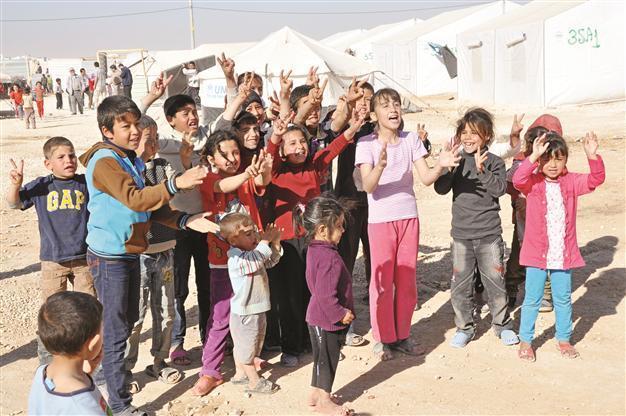Syrian refugee tragedy crosses border into Jordan
MAFRAQ

Nearly 60 percent of refugees in Jordan’s Zaatari Refugee camp are women and children under 17 years old, according to official figures. Officials say the total number of refugees could hit one million in the first half of this year. DAILY NEWS photo, Serkan DEMİRTAŞ
The beautiful landscape over the al-Wehda Dam on the Yarmouk River marking the border between Jordan and Syria has turned into the theater of a massive humanitarian crisis, as nearly hundreds of thousands of Syrian refugees have crossed into Jordan in the last two years of Syrian turmoil.
As the official number of refugees exceeded 400,000 last week with no hope of an immediate solution to the ongoing crisis in Syria, Jordanian officials in Amman express their concerns that the refugee toll could hit one million only in the first half of this year.
Abdulmain, a refugee in the UNHCR’s Zaatari Refugee Camp, however, is very concerned that he will never return to his home again as he is 70 years old and suffering from several maladies. “Thank God I saved my family. My seven children and 20 grandchildren are all with me in this camp. I do not think I can ever return my home but I believe our prayers will prevail and my children and their children will be back to our homeland one day,” he said through an interpreter. He is just one of the Syrians who left his house in Daraa, right on the other side of the border.
Unprecedented recent increaseAs the clashes between the regime forces supported by Hezbollah and the Free Syrian Army (FSA) escalate in southern Syria, the flow of refugees has increased in unprecedented numbers, according to a Jordanian military official on the border. “Last night was a remarkable one. A total of 4,659 Syrians crossed the border in the area of our responsibility,” Br. Gen. Mohammed Habesnekr told a group of visiting Turkish journalists. Jordan has a 387-kilometer-long border with Syria and has 25 border crossings.
Refugees fleeing violence flocked to the roads into Jordan through the al-Wehda Dam also known as the Unity Dam, which was constructed by a Turkish company, passing through the dam lake by boat. When they reach the shore they are being collected by the Jordanian army to be transported to a sort of assembly camp from where they are transferred to the Zaatari refugee camp after the conclusion of registration procedures.
“My relatives who are already in the camp told us that the camp is safe and good for children. The amount of pressure is growing everyday so we have decided to go to Jordan,” a 44-year-old woman said, refusing to give her full name as her husband was still in Daraa with plans to join the Free Syrian Army. “We were sleeping in our house last night but today we are behind fences and we do not know what will be our destiny,” she said.
Nearly 60 percent of refugees are women and children under 17 years old, according to the Zaatari refugee camp director, Mahmoud al-Amoush, and each refugee has their own story of how they escaped violence committed by either regime forces or armed regime supporters, known locally as the shabiha.
Mohammed, who brought his family to the camp, said he will be back to Syria to continue fighting alongside the FSA. “[The Shabiha] are brutal. They are massacring innocent, unarmed people. They burn houses and force people to rat on those who support the FSA,” he said, adding he was sure Syrians will topple Bashar al-Assad no matter how long it would take and what it costs.
“We are very disappointed with the world’s insensitivity and inaction,” another refugee said, “This makes us angry.” Although world powers and regional heavyweights are still far from actively interfering in Syria, they tend to be more visible in the humanitarian side of the crisis by providing aid to refugees, although it has been found insufficient by Jordanian officials. “Only last year we spent $600 million on refugees and we have been provided only $200 million. We are not a rich country and additionally struggling to overcome our own economic problems. To be frank, what we see is world leaders coming here only for a photo opportunity,” a high-level Jordanian official said under conditions of anonymity.
Water: The most important problemSome 38 non-governmental organizations are active in the camp, where three hospitals were established by France, Italy and Morocco, and a school by Bahrain, al-Amoush said. The most important complaint voiced by refugees is lack of water, something camp management is trying to deal with. “Daily consumption of water in the camp is 2.5 million liters. We have 45 trucks to distribute water for refugees. We are working hard to get over this issue,” he said.
Despite these difficulties, Syrians are hopeful for the future. “Inshallah we will be back to Syria. I have faith in God. I will kiss the land when I return. This is the most sacred thing for us. One day, we will leave everything behind and go back home,” a woman in her sixties said.
